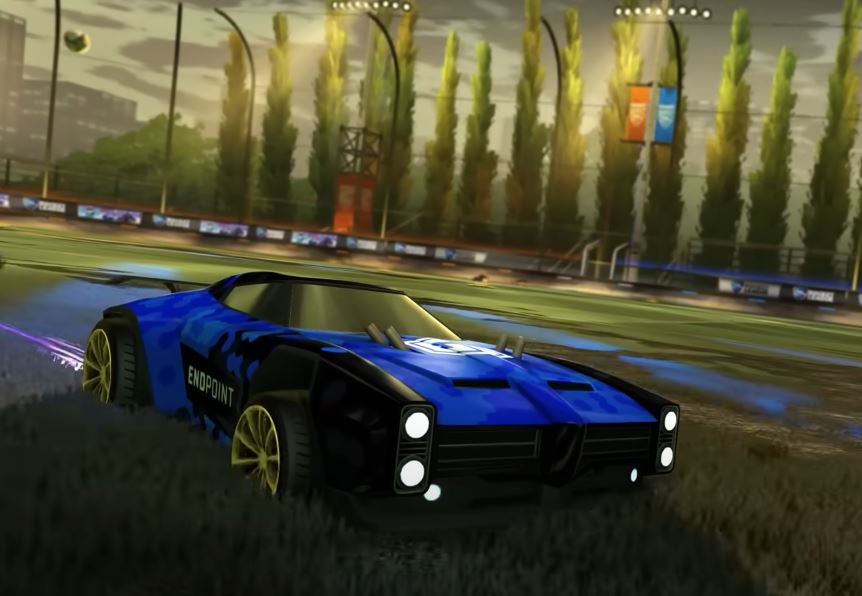Ever since Rocket League's debut in 2015, the game's ability to acquire corporate sponsorships and tie-ins has increased exponentially. Seven and a half years later, the game now hosts a considerable selection of both real and pop culture vehicles, from Aston Martin to Ford, ranging from sporty to military grade. You'd think somewhere within this selection, there would be a winner in the eyes of the public. However, outside of some fairly popular outliers, none of these cars have had the staying power to topple the best. So, what about licensed cars makes them non-meta? Is there really such a thing as an artificial barrier to becoming top dog?
The Early Days of Licensed Cars
Rocket League kicked off its licensed car lineup with Sweet Tooth from the Twisted Metal series right from launch. If you also forgot that Rocket League had licensed cars right from the get-go, it's probably because this car was exclusive to the PS4 and could only really be seen if you were also on PS4. This exclusivity wasn't the end of the game times either. The Xbox One release at the start of 2016 introduced the Armadillo from Gears of War and the Warthog from Halo — all very iconic vehicles unfortunately locked away from PC by exclusivity.
The Most Iconic Licensed Car
Early in 2016, the game would get its most iconic licensed car with the 2016 Batmobile. Rudy talked extensively about this car in another episode, but know that it had one of the largest impacts on the competitive scene out of any tie-in vehicle.
The Rise of Larger Tie-Ins
Jumping to the present, after a very successful few years and an acquisition by Epic Games, Rocket League has the standing and backing to host much larger entities, such as real-world manufacturers and blockbuster movies, and does so on an increasingly frequent basis. These cars have a few advantages over the homegrown offerings created by Psyonix, but their main advantage is that they are based on real or at least culturally significant cars, which have their own pre-established standings and reputations. This is a considerable leg up compared to freshly designed battle cars, which often have none of that. You certainly couldn't ask for the over 1,000 credits that these licensed battle cars are listed for if it wasn't the case.
The Downsides of Licensed Cars
But obviously, if these cars were nothing but positives, we wouldn't really be covering them here. So, what are the numerous reasons that these cars will never see the cultural and professional meta?
Price
The first one is obvious and one we mentioned already: price. Any cost higher than zero is going to be a roadblock on the way to the meta, and particularly in the case of most modern offerings, that price is often $10 to $20, often rivaling the original cost of the game. This puts these cars outside of the price range of most players, most still of school age. Throw that against the Octane, which is free, and it's hard not to see why it would be difficult for even a very strong popular car to break into the space.
Availability
Next up, we have availability. Oftentimes, these licensed cars are only available for a short window of time, usually a handful of weeks in line with certain events. These cars usually coincide with a cross-promotion of some sort, like the release of a film or a live event. Once that time has passed, the cars always rotate out and are otherwise unable to be acquired. This limited availability often hinders their ability to propagate amongst players over longer periods of time and further prevents them from entering the meta. Items brought via the item shop are also untradable, which means they can't be circulated around the player base like other items can.
Lack of Customization
Practically all licensed content has one thing in common when it comes to Rocket League: a severe lack of customization. Although a good-looking car doesn't make or break the game meta, having the option of customizing your car to suit your style goes a long way to keeping it fresh. Oftentimes, due to licensing agreements, these cars seldom have any options, sometimes not even coloring.
Real-World Design Constraints
Something minor but worth noting is that these cars are beholden to their real-world designs, something that homebrew battle cars are not. This means that sometimes these licensed cars aren't perfect fits for any of the hitboxes. The hitboxes are pre-accommodating as they are, but it can be sometimes fairly obvious when Psyonix is reaching a bit to get a vehicle in-game, either through the scale of the vehicle or how forgiving they are of the fit.
Looking at all of this, it's clear why these cars aren't shooting for the meta — they're not designed to be. Ignoring how awkward it would be for Psyonix to have a paid-for vehicle be at the forefront of the meta, it's clear that these cars are here to carve their own niche for fans of the products or manufacturers. Game tie-ins with other media are becoming increasingly popular as the medium itself grows both socially and economically. We do see the occasional real-world car pop up in professional play, mostly by those who have the skill to back up a bit of flair. Would I bet that they would keep using them in a series if it came down to the wire? Absolutely not. But it'll always be cool to see proof of just how far Rocket League has come.
